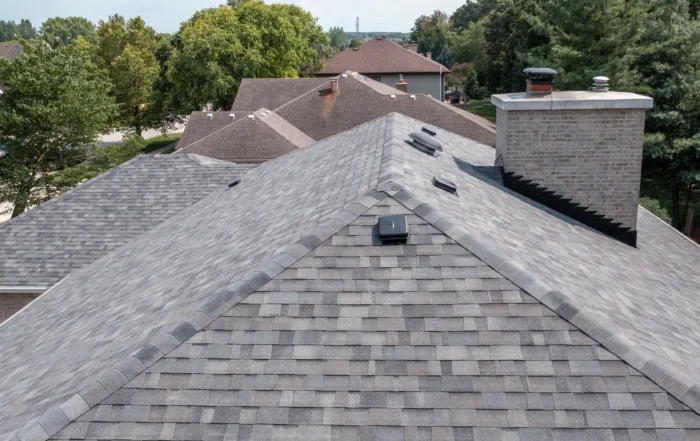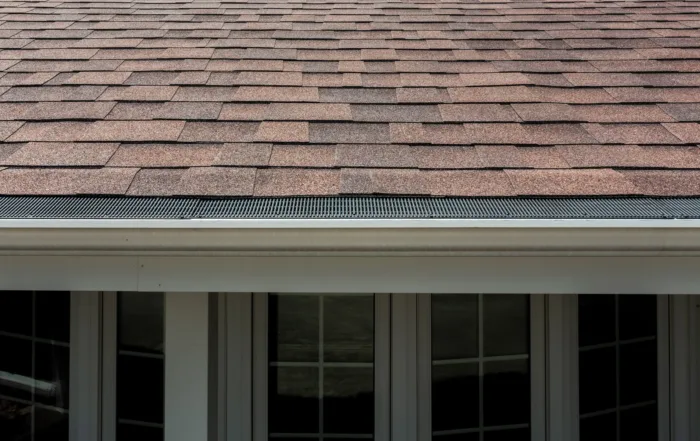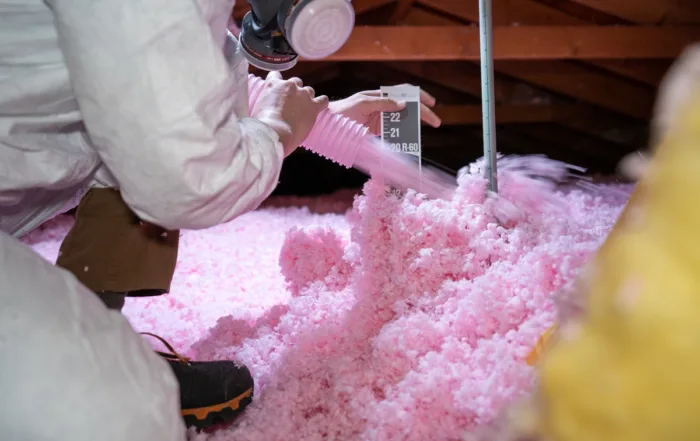Did you know that up to 85% of a home’s heat can escape through an improperly insulated attic? It’s true, and what’s even more important is that you can prevent much of that loss with proper attic insulation.
Your home’s attic sits between the roof deck and the ceiling of the floors below. No matter how large or small this space is, this pocket of air could influence temperatures in the rest of your home, directly impacting energy bills. The EPA estimates you could reduce heating and energy costs by as much as 15% by air sealing your homes and adding insulation to attics and floors in crawl spaces and basements.
Attic insulation is a necessary investment and, over time, you will need to add additional protection with new layers of insulation to block out cold air from infiltrating the rest of your home. Doing so can drastically improve whole-home comfort.
What Is Insulation Anyway?
Fiberglass and cellulose are two common types of insulation used in attic spaces. Commonly installed using a blow-in method, the material covers cracks, crevices, and gaps that allow air to leak from the heated or cooled space below, reducing heat loss or heat gain, depending on the time of year.
Consider some of the reasons why it is essential to install the best insulation for attic spaces now before the coldest air of the season comes in.
Reduce Heating Costs with Proper Insulation
Insulation reduces heating and cooling costs in your home. You want the heat you have paid for to stay in your home as long as possible. Insulating the attic of your home enables heated air to remain within the home longer instead of escaping. Insulating your home helps retain the desired temperature more effectively, reducing your costs.
As warm air rises in your home, 85% of that heat may escape through the attic. Because most attics are insufficiently insulated, more air leaves the main living area than it should, leading to higher gas bills in the winter. By utilizing attic floor insulation, you create a barrier that significantly prevents heated air from moving upward and out of your home and instead traps it in the living spaces where you need it. By increasing or replacing attic insulation with better protection, you maintain lower gas and electric bills throughout the year.
Consider a visual representation of this. Imagine a thick layer of insulation over the top of your attic floor, which is also the ceiling in your living area. That thick insulating layer traps the warm air in your living area and means your home’s heating system won’t have to work as often or as hard to keep your home at the temperature you desire.
Insulate to Prevent Ice Dams
The value of installing insulation in the attic spaces is made even more valuable when you consider how it may prevent leaks from ice dams. During the fall, winter, and early spring months, ice dams form when moisture freezes and thaws during temperature changes. As temperatures drop, the moisture freezes, expanding the area and pushing its way into roofing materials. This creates small cracks in the roofing material. Those tiny cracks allow moisture to seep into the home, increasing the risk of mold and mildew development.The value of installing insulation in the attic spaces is made even more valuable when you consider how it may prevent leaks from ice dams. During the fall, winter, and early spring months, ice dams form when moisture freezes and thaws during temperature changes. As temperatures drop, the moisture freezes, expanding the area and pushing its way into roofing materials. This creates small cracks in the roofing material. Those tiny cracks allow moisture to seep into the home, increasing the risk of mold and mildew development.
Attic ceiling insulation helps prevent this from occurring. A well-insulated and well-ventilated attic space promotes proper air circulation. When 15 to 20 inches of blown-in fiberglass insulation is in place (or more insulation for roofs with larger attic spaces), you gain protection from ice dams. The National Weather Service recommends R-value attic insulation of at least R-30.
Because the insulation keeps air contained in the home, it helps safeguard against air warming the attic. And a properly installed roof assures that air in the attic is ventilated, meaning it is closer in temperature to the air outside. There’s less opportunity for ice to form in these areas, reducing the risk of damage to the roofing structure. Learn more about ice dams and how costly and worrisome they can be. Then, attic floor insulation will be installed to prevent them from occurring.
Add Insulation to Improve Indoor Air Quality
Insulation can make your home feel more comfortable, too. A quality product installed in your home’s attic spaces creates more regulated and even control of heating and cooling. When you add blown-in fiberglass insulation to your attic spaces, you can literally feel the difference. The temperature in your home is more consistent.
Additionally, insulation helps seal the attic space, preventing pollutants from infiltrating the area. Dust, debris, allergens, or mold located in the attic have less opportunity to infiltrate your home. To have an energy-efficient home, start by filling in those gaps that allow heated air to escape so easily. This may directly improve your air quality.
Add Value to Your Home
Are you planning to sell your home soon? If so, you can significantly improve the resale value by making sure it is well insulated. That does a few things for you.
First, when a prospective buyer is walking through the home, the cozy, warm space in the cold winter months is an attractive feature. More so, as soon as those prospective home buyers take a look at your recently added insulation, they know your home is more energy efficient than others. That saves them money. A comfortable, well-maintained home that has lower energy costs and recently added insulation may lead to a higher value than a home that is chilly and costly to heat.
Many of today’s home buyers want a ready-to-move-into home. They don’t want to invest money and time in completing updates, such as dealing with those pesky drafts.
Prolong the Life of Your HVAC
Another way adding insulation to your home could be beneficial is by simply reducing the wear and tear on your home’s heating and cooling system. Some surveys indicate that a new HVAC system for a home can range from $5,000 to $12,500. If you can delay that out-of-pocket cost for a few years by extending the life of your existing system, that’s well worth it. These systems should last 15-25 years or longer.
With improved energy efficiency from added insulation, your home’s HVAC system works better and less. That’s going to extend the life of it for years to come (along with proper maintenance and upkeep). With more insulative protection, you’ll also see far fewer pollutants making their way into the system. That, too, can help the HVAC work more efficiently.
Work Toward an Eco-Friendly Home
You can learn how to build an energy-efficient home in many ways. However, there is no better way to improve the environment than to reduce your carbon footprint. Investing in insulation is an eco-friendly decision.
When you have ample insulation in place, your heating and cooling system doesn’t work as hard to warm temperatures. You maintain a comfortable space, but your furnace doesn’t work nearly as well. That means less fossil fuel energy, such as natural gas, is being used, which is also good for the environment.
Where To Use Insulation in Your Home
A professional energy audit provides exacting insight into where you can improve your property’s efficiency. For many property owners, the attic is a sensible place to start. Adding more insulation to the attic flooring creates an opportunity to reduce heat loss across your home’s square footage.
You may also benefit from adding insulation to other areas, such as the walls and floors. The EPA shares that insulating exterior walls, especially those between living spaces and unheated garages, shed roofs, and storage areas, can be significantly beneficial. Insulate the attic access door and dormers as well. Any unconditioned spaces in your home could benefit from insulation.
How Much Does Attic Insulation Cost?
It’s a valid question for many people, but knowing the answer can be challenging. There are various factors that play a role in determining the cost of attic insulation, including:
- The type of insulation being placed
- The amount of insulation needed
- Whether the existing material is being removed
- The size and expansiveness of your home
- The type of structure you have
- Where you live
Because so many factors play a role in determining the actual cost of attic insulation, the best step is to request a quote. You will be able to learn more about the best type of attic insulation for your home, any specific needs for the removal of old or damaged insulation, and an the assessment of your attic’s condition. process.
If you are ready to get rid of the drafts and save money on your home’s heating and cooling costs (attic insulation also reduces the cost of cooling our home), contact us. Lang Home Exteriors brings years of experience and outstanding customer service to every project we take on. Reach out to us for an attic insulation consultation.




